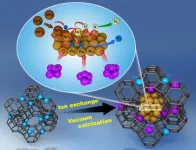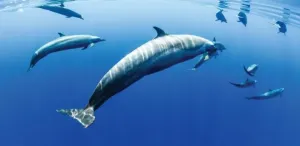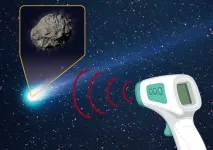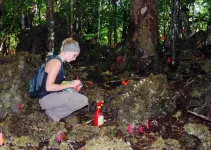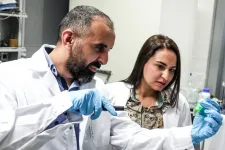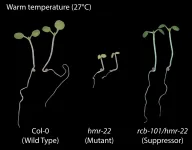For chronic kidney disease, an ounce of prevention can be economical
University of Tsukuba study identifies a cost-effective way of getting health-care professionals to better manage treatment of chronic kidney disease and extend patients' lives
2021-04-06
(Press-News.org) Tsukuba, Japan - With a prevalence of about one in 10 people worldwide, chronic kidney disease (CKD) is a global health problem. It also often goes undetected, leading to a range of negative health outcomes, including death. Catching it at an early stage and adjusting nutrition and lifestyle can improve and extend life, but only if there are economically feasible systems in place to promote and educate on this.
Amid finite health-care resources, any CKD intervention must be both practical and cost-effective. A team of researchers centered at the University of Tsukuba now believe they have found a CKD behavioral intervention that can be delivered at a reasonable cost. They published their findings in the Journal of Renal Nutrition.
Changing eating and lifestyle habits, and regularly visiting a doctor, are vital in managing CKD. Yet the CKD treatment guidelines under Japan's nationalized health-care system offer little economic incentive for general physicians (GPs) to recommend dietitians' valuable guidance for CKD patients.
"There's substantial evidence, including the Japanese Society of Nephrology's clinical guidelines, that dietitian-led patient education can slow the progression of CKD," study corresponding author Professor Masahide Kondo says. "But this sort of education seldom happens in Japan. We sought a way to justify such interventions and incentivize GPs to initiate them."
With a lack of economic assessments of these interventions, the researchers conducted a cost-effectiveness analysis using a Markov model, a mathematical method for finding patterns and making predictions. Based on results from the Frontier of Renal Outcome Modifications in Japan (FROM-J) study, which found success in dietitian-led education and lifestyle advice, along with periodic check-ups, they projected how such intervention would perform economically.
Naturally, a host of factors, such as disease progression and drug costs, play into this complex modeling. Key here was whether the incremental cost-effectiveness ratio (ICER), which shows the unit cost of gaining 1 extra healthy life year among the patients via the intervention, gave sufficient worth for that amount. The estimated ICER of about US$1,324 per quality-adjusted life year (QALY) was compared with the suggested social willingness to pay about US$45,455 for a 1-QALY gain. This demonstrates considerable cost-effectiveness.
"Diffusing such CKD interventions now seems justifiable, even with limited health-care resources," study first author Assistant Professor Reiko Okubo says. "We found that by adjusting the reimbursements and accessing the country's 5,000 registered dietitians, we could incentivize GPs to encourage practical behavioral interventions."
Behavior modification for CKD patients has the potential to be cost-effective within Japan's national health-care scheme. It can also improve and extend lives. Such findings could extend to other countries and encourage them to modify their guidelines. If policy can follow suit and GPs can comply with the advice, CKD can become a more manageable, and less fatal, disease.
INFORMATION:
The article, "Cost-Effectiveness of Behavior Modification Intervention for Patients With Chronic Kidney Disease in the FROM-J Study," was published in Journal of Renal Nutrition at https://doi.org/10.1053/j.jrn.2020.12.008
ELSE PRESS RELEASES FROM THIS DATE:
2021-04-06
For the implementation of the effective hydrogen economy in the forthcoming years, hydrogen produced from sources like coal and petroleum must be transported from its production sites to the end user often over long distances and to achieve successful hydrogen trade between countries. Drs. Hyuntae Sohn and Changwon Yoon and their team at the Center for Hydrogen-fuel Cell Research of the Korea Institute of Science and Technology (KIST) have announced a novel nanometal catalyst, constituting 60% less *ruthenium (Ru), an expensive precious metal used to extract hydrogen via ammonia decomposition.
*Ruthenium is a metal with the atomic number 44, and is a hard, expensive, silvery-white member of the platinum group of elements.
Ammonia has recently emerged as a liquid storage and transport ...
2021-04-06
Epidemiological studies have found that transportation noise increases the risk of cardiovascular morbidity and mortality, with high-quality evidence for ischaemic heart disease. According to the WHO, ?1.6 million healthy life-years are lost annually from traffic-related noise in Western Europe. Traffic noise at night causes fragmentation and shortening of sleep, elevation of stress hormone levels, and increased oxidative stress in the vasculature and the brain. These factors can promote vascular dysfunction, inflammation and hypertension, thereby elevating the risk of cardiovascular ...
2021-04-06
Humans have altered the ocean soundscape by drowning out natural noises relied upon by many marine animals, from shrimp to sharks.
Sound travels fast and far in water, and sea creatures use sound to communicate, navigate, hunt, hide and mate. Since the industrial revolution, humans have introduced their own underwater cacophony from shipping vessels, seismic surveys searching for oil and gas, sonar mapping of the ocean floor, coastal construction and wind farms. Global warming could further alter the ocean soundscape as the melting Arctic opens up more ...
2021-04-06
The world's first ground-based observations of the bare nucleus of a comet nearing the end of its active life revealed that the nucleus has a diameter of 800 meters and is covered with large grains of phyllosilicate; on Earth large grains of phyllosilicate are commonly available as talcum powder. This discovery provides clues to piece together the history of how this comet evolved into its current burnt-out state.
Comet nuclei are difficult to observe because when they enter the inner Solar System, where they are easy to observe from Earth, they heat up and release gas and dust which ...
2021-04-06
April 06, 2020-- A new commentary published online in the Annals of the American Thoracic Society provides an exhaustive examination of published research that discusses whether air pollution may be linked to worse COVID-19 outcomes. The studies that the authors examined look at several potential disease mechanisms, and also at the relationship between pollution, respiratory viruses and health disparities.
In "COVID-19 Pandemic: A Wake-Up Call for Clean Air," Stephen Andrew Mein, MD, Department of Medicine, Beth Israel Deaconess Medical Center, Boston, and colleagues ...
2021-04-06
A University of Guam review of published research on the critically endangered Serianthes nelsonii tree has revealed a reason why the population of the trees continues to be endangered despite a long history of funded conservation projects and a national recovery plan implemented 26 years ago. The review article, co-authored by biologists of the Plant Physiology Laboratory of UOG's Western Pacific Tropical Research Center, was published on March 2 in Horticulturae journal (doi:10.3390/horticulturae7030043).
"A main message of our paper is that decision-makers from funding agencies limit conservation success when practitioners ...
2021-04-06
A revolutionary technology developed within the END ...
2021-04-06
WASHINGTON, April 6, 2021 -- Home brewing enthusiasts and major manufacturers alike experience the same result of the beer-making process: mounds of leftover grain. Once all the flavor has been extracted from barley and other grains, what's left is a protein- and fiber-rich powder that is typically used in cattle feed or put in landfills. Today, scientists report a new way to extract the protein and fiber from brewer's spent grain and use it to create new types of protein sources, biofuels and more.
The researchers will present their results today at the spring meeting of the American Chemical Society (ACS). ACS Spring 2021 is being held online April 5-30. Live sessions will be hosted April 5-16, ...
2021-04-06
By 2050 global warming could reduce crop yields by one-third. UC Riverside researchers have identified a gene that could put the genie back in the bottle.
Warmer temperatures signal to plants that summer is coming. Anticipating less water, they flower early then lack the energy to produce more seeds, so crop yields are lower. This is problematic as the world's population is expected to balloon to 10 billion, with much less food to eat.
"We need plants that can endure warmer temperatures, have a longer time to flower and a longer growth period," said UCR botany and plant sciences professor ...
2021-04-06
DALLAS, April 6, 2021 -- A tsunami of chronic health conditions as a result of the SARS-CoV-2 pandemic, especially cardiometabolic disease, may produce an enormous wave of death and disability that demands immediate, comprehensive strategies. In addition, COVID-19 has disrupted cardiovascular science and medicine, yet it presents opportunities to transform and create novel approaches that can yield new successes. These are the opinions of two esteemed leaders in cardiovascular disease care, research and strategy, detailed in two new Frame of Reference articles published today in the American Heart Association's flagship journal Circulation.
While COVID-19 has severely impacted everyone's daily lives, its societal ...
LAST 30 PRESS RELEASES:
[Press-News.org] For chronic kidney disease, an ounce of prevention can be economical
University of Tsukuba study identifies a cost-effective way of getting health-care professionals to better manage treatment of chronic kidney disease and extend patients' lives
